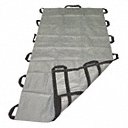Patient Movement Using Log Roll
The log roll is a quintessential part of EMT movement practices. Log rolling is often used as a way to place a patient on some type of movement device such as a backboard or redi-bed patient mover. Manual C-spine precautions should be used when log rolling a patient with a traumatic injury with suspected spinal cord injury. A minimum of 2 rescuers is required to perform a log roll during a traumatic situation, although 3-4 rescuers produces the best result.
Log Roll Procedure[edit | edit source]
- If utilizing spinal precautions, place a rescuer at the head to maintain manual cervical spinal immobilization.
- If using only 2 rescuers, make sure to position the movement device on the opposite side of the patient to allow for easy insertion by the rescuers.
- Place second rescuer at the patient's hips/waist. If 3 rescuers available, one rescuer is placed at the torso and one at the legs. 4 rescuer log roll adds the last rescuer behind the patient with the movement device in hand. In the 3 and 4 rescuer technique, direct the rescuer at the torso to grab at the patient's shoulder and low buttocks/high leg area and the rescuer at the legs to grab the knee and the waist or belt/waistband (if there is one). This should form an "X" with these rescuers arms and prevent independent movement and rotation of the spine.
- Roll the patient towards the rescuers. This allows for a backboard to to placed behind the patient if necessary and if the rescuers lose their grip, the patient will not "roll away".
- Rescuer 4 will then place the movement device behind the patient and assess their back if necessary.
- Roll the patient back onto the movement device and center them as needed.
Patient Movement with Patient Mover[edit | edit source]

Patients who are non-ambulatory (cannot walk on their own) may be moved to the gurney in many different ways such the sit-pick maneuver or movement by draw-sheet. Both of these maneuvers are useful if the patient is in close proximity to the gurney. In the event that the patient is located in an area that is inaccessible by the gurney or the patient is large enough that a draw-sheet or sit-pick will not work, a commercial patient mover may be used. Patient movers go by many names such as Redi-Beds or Mega-Movers and are essentially reinforced tarps with many handles around the edges. Patient movers are made to be carried or dragged and are useful in moving both patients in difficult to access areas and bariatric patients. A patient may be placed on a mover by a variety of methods, but by far the most common is the log roll described above (c-spine immobilization is not needed). In this case, while the patient has been rolled to one side, half of the mover is bunched up long-ways and pushed as far under the patient as possible. The patient is then rolled to their other side which frees the part of the patient mover that was trapped under the patient. The patient is then returned to the supine position; the patient should be close to centered on the patient mover and can be carried (or dragged if necessary) to the gurney for packaging and transport.
Self Assessment[edit | edit source]
- Test your knowledge with this quiz.
Tips and Tricks[edit | edit source]
- If needed, "pre-roll" the patient's feet by crossing the farthest one over the closest one. This provides a temporary anatomical splint that will prevent the patient's lower legs from going awry when rolling a patient with few rescuers available. This technique also helps with optimal positioning in the recovery position.
